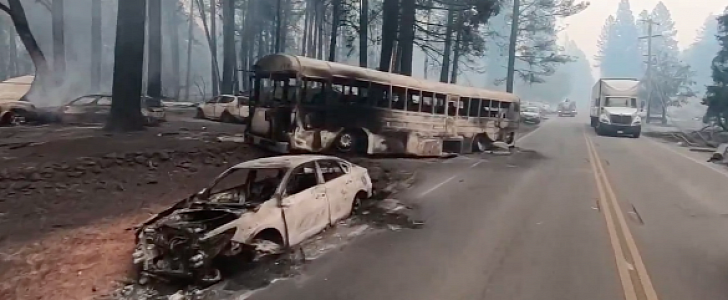In recent days, a huge wildfire in the Sierra Nevada foothills has kept the headlines as the deadliest such event in California since 1991. With 23 people confirmed dead so far, a series of videos showing people in cars trying to escape the blaze surfaced.
For most, using their cars to get out of what became known as the Camp Fire was the only choice. Unfortunately, cars are not usually equipped with filters powerful enough to make the highly toxic air breathable again.
As usual when some disaster takes place somewhere on Earth, Elon Musk didn’t waste any time in making a Twitter appearance, announcing that “Model S & X have hospital-grade HEPA filters. Maybe helpful for transporting people.”
These filters were announced by Tesla back in 2016 when they were introduced to the Model X and Model S as part of the company’s “Defense System against Bacteriological Weapons.“ Aside from hospitals, they are also used in clean rooms and in the aerospace industry.
Tesla said at the time its filtration system can eliminate pollen, bacteria and pollutants before they enter the cockpit, while the inside air is also cleaned for any traces of such harmful particles.
“The end result is an air filtration system nearly 100 times more efficient than the systems traditionally used in the automotive industry,” said Tesla.
In its early days, the system was tested under real-life conditions on California highways and in Chinese cities during peak hours, near marshes, landfills and spill areas. Never before has it been tested in the middle of a wildfire.
During the Camp Fire, a series of posts on social media began spreading the word that the filters do a great job at filtering particles caused by fire as well. There’s a particular image, posted by Tesla owner Andrei Bulu and first shown on Teslarati, which shows how much of a difference there is between the air inside of the car and the one outside.
The measurements are of course not official and have been made with the help of a particulate detector which appears to have been purchased online. Even so, the difference between the air quality inside the car and outside is enormous: fine particles at 2 μg / m3 with the windows closed vs. 105 μg / m3 outside.
To put that into perspective, the EPA defines a good air quality at 0 to 12 μg / m3 for this type of fine particles.
If the measurements are accurate, this could mean there's some truth to Musk's appeal to use Tesla's as rescue vehicles in this type of situation.
So would you use your Tesla to get people back to fresh air in a similar situation?
As usual when some disaster takes place somewhere on Earth, Elon Musk didn’t waste any time in making a Twitter appearance, announcing that “Model S & X have hospital-grade HEPA filters. Maybe helpful for transporting people.”
These filters were announced by Tesla back in 2016 when they were introduced to the Model X and Model S as part of the company’s “Defense System against Bacteriological Weapons.“ Aside from hospitals, they are also used in clean rooms and in the aerospace industry.
Tesla said at the time its filtration system can eliminate pollen, bacteria and pollutants before they enter the cockpit, while the inside air is also cleaned for any traces of such harmful particles.
“The end result is an air filtration system nearly 100 times more efficient than the systems traditionally used in the automotive industry,” said Tesla.
In its early days, the system was tested under real-life conditions on California highways and in Chinese cities during peak hours, near marshes, landfills and spill areas. Never before has it been tested in the middle of a wildfire.
During the Camp Fire, a series of posts on social media began spreading the word that the filters do a great job at filtering particles caused by fire as well. There’s a particular image, posted by Tesla owner Andrei Bulu and first shown on Teslarati, which shows how much of a difference there is between the air inside of the car and the one outside.
The measurements are of course not official and have been made with the help of a particulate detector which appears to have been purchased online. Even so, the difference between the air quality inside the car and outside is enormous: fine particles at 2 μg / m3 with the windows closed vs. 105 μg / m3 outside.
To put that into perspective, the EPA defines a good air quality at 0 to 12 μg / m3 for this type of fine particles.
If the measurements are accurate, this could mean there's some truth to Musk's appeal to use Tesla's as rescue vehicles in this type of situation.
So would you use your Tesla to get people back to fresh air in a similar situation?
If Tesla can help people in California wildfire, please let us know. Model S & X have hospital grade HEPA filters. Maybe helpful for transporting people.
— Elon Musk (@elonmusk) 10 noiembrie 2018
Horrible Bay Area air quality due to Paradise, CA fire... Check out this laser particle counter "Window Up / Window Down" test using the Model X Bio-Defense filter. Thank you Tesla! pic.twitter.com/iefEtRStqy
— Andrei B (@AndreiBulu) 9 noiembrie 2018

